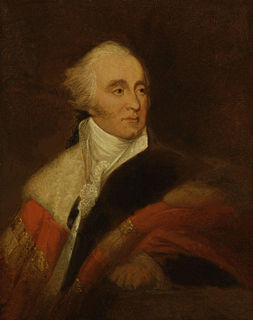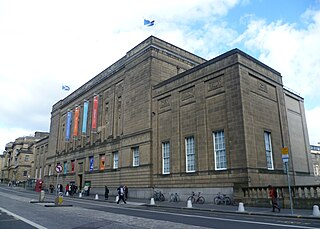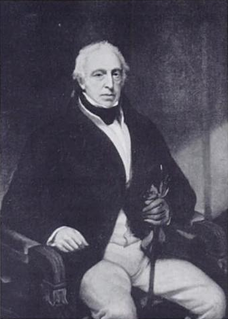
Gilbert Elliot-Murray-Kynynmound, 1st Earl of Minto,, known as Sir Gilbert Elliott, 4th Baronet until 1797, and The Lord Minto from 1797 to 1814, was a British diplomat and politician who sat in the House of Commons between 1776 and 1795. He was viceroy of the short-lived Anglo-Corsican Kingdom from 1793 to 1796 and went on to become Governor-General of India between July 1807 and 1813.

Gilbert John Elliot-Murray-Kynynmound, 4th Earl of Minto,, known as Viscount Melgund by courtesy from 1859 to 1891, was a British peer and politician who served as Governor General of Canada, the eighth since Canadian Confederation, and as Viceroy and Governor-General of India, the country's 17th.
Gilbert Elliot, Elliott or Eliott may refer to:

Gilbert Elliot-Murray-Kynynmound, 2nd Earl of Minto,, styled as Viscount Melgund between 1813 and 1814, was a British diplomat and Whig politician.

Earl of Minto, in the County of Roxburgh, is a title in the Peerage of the United Kingdom. It was created in 1813 for Gilbert Elliot-Murray-Kynynmound, 1st Baron Minto. The current earl is Gilbert Timothy George Lariston Elliot-Murray-Kynynmound, 7th Earl of Minto.

The National Library of Scotland (NLS) is the legal deposit library of Scotland and is one of the country's National Collections. As one of the largest libraries in the United Kingdom, it is a member of Research Libraries UK (RLUK) and the Consortium of European Research Libraries (CERL).
The Bannatyne Club, named in honour of George Bannatyne and his famous anthology of Scots literature the Bannatyne Manuscript, was a text publication society founded by Sir Walter Scott to print rare works of Scottish interest, whether in history, poetry, or general literature. The club was established in 1823 and printed 116 volumes before being dissolved in 1861.
(Gilbert) Timothy Lariston Elliot-Murray-Kynynmound, 7th Earl of Minto, styled Viscount Melgund between 1975 and 2005, is the chief executive of British stationery company Paperchase. He is the son of the late Gilbert Elliot-Murray-Kynynmound, 6th Earl of Minto and his first wife, Lady Caroline Child Villiers. The Earl resides in England, but has continuing links with Scotland, as his parents did.

Clan Eliott is a Border Reiver Scottish clan.

Hugh Elliot was a British diplomat and then a colonial governor.
Gilbert Edward George Lariston Elliot-Murray-Kynynmound, 6th Earl of Minto,, styled Viscount Melgund until 1975, was a Scottish peer.
William Hugh Elliot-Murray-Kynynmound, 3rd Earl of Minto, was a British Whig politician. He was the eldest son of Gilbert Elliot-Murray-Kynynmound, 2nd Earl of Minto.

Arthur Ralph Douglas Elliot-Murray-Kynynmound, known as Arthur Elliot, was a British journalist and Liberal Unionist politician.
Hugh Frederick Hislop Elliot, was a British Liberal and Liberal Unionist politician who sat in the House of Commons from 1885 to 1892.

Sir Gilbert Elliot, 3rd Baronet, was born at Minto, Roxburghshire, and was a Scottish statesman, philosopher and poet.
Victor Gilbert Lasiston Garnet Elliot-Murray-Kynynmound, 5th Earl of Minto was a member of the British nobility. He was the son of Gilbert John Elliot-Murray-Kynynmound, 4th Earl of Minto and Lady Mary Caroline Grey. He married Marion Cook, daughter of George William Cook, on 19 January 1921. He died in 1975.
Elliot-Murray-Kynynmound may refer to:

The John Murray Archive is a collection of 234 years' worth of manuscripts, private letters, and business papers from various notable, mostly British, authors including correspondence between Mary Shelley and Lord Byron, and letters of Jane Austen and Charles Darwin. The Archive consists of over a million items, valued at more than £100 million, and is kept at the National Library of Scotland (NLS) in Edinburgh, Scotland.
The India Papers collection is an archive containing roughly 4,200 bound volumes dated from the post-Mutiny reorganisation of the Indian government up until Indian Independence in 1947 and is essentially a collection of almost all things relating to British India. There are large sections devoted to the state's medical history, human rights, military history, education, industry and trade, travel, politics, religion, arts, and various other subjects. Notable documents in the archive include important documentation concerning eye-witness accounts of the Partition riots and the police reports on Gandhi's political meetings. The rare collection is held at the National Library of Scotland (NLS) in Edinburgh, Scotland. Only one other collection of similar size and content can be found in the UK, the India Office Records, which are held at the British Library in London. The India Papers are complemented further by more the substantial collections in India and in the United States.










